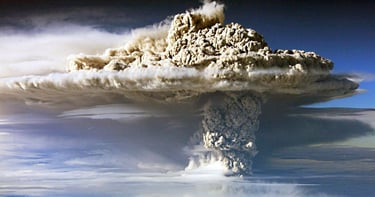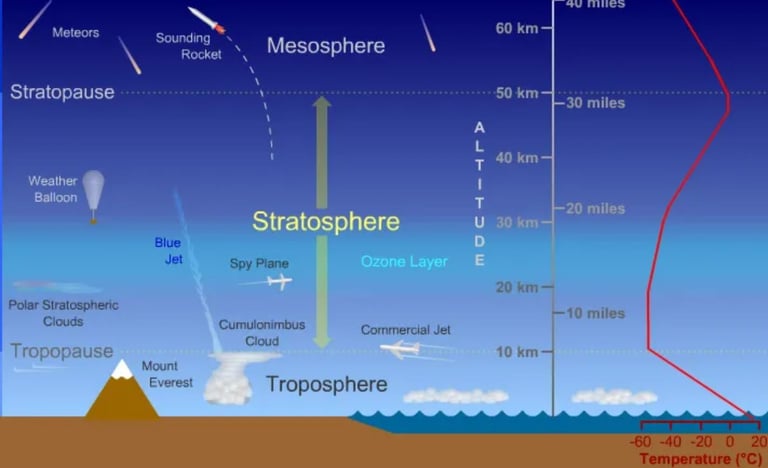

We are not climatologists or meteorologists, nor do we claim to be. That said, we do see patterns, and understand cause and effect principle of dangerous weather patterns becoming more severe as a result of natural disasters. Let's discuss.
In January 2022, the Hunga Tonga-Hunga Ha'apai volcano experienced a significant eruption, resulting in the expulsion of volcanic material reaching heights of up to 58 kilometers, penetrating the mesosphere. To put this into perspective, it is worth noting that the majority of Earth's weather systems occur within the first 10 kilometers of the atmosphere, known as the troposphere. The eruption triggered a devastating tsunami, with waves measuring nearly 15 meters in height, which ravaged coastal villages and caused widespread destruction. Additionally, the eruption generated a powerful sonic boom that reverberated around the globe, not once, but twice. This series of explosive events commenced on January 15, 2022, and unleashed atmospheric shock waves, sonic booms, and tsunami waves that traversed vast distances.
One remarkable consequence of the eruption was the colossal plume of water vapor that ascended into Earth's stratosphere. The volume of water vapor released was estimated to be equivalent to filling over 58,000 Olympic-size swimming pools or 146 metric megatons of water, which subsequently transformed into vapor. It is worth noting that water vapor is a greenhouse gas, similar in effect to carbon dioxide, although the latter is typically the focus of human-induced climate change discussions due to our ability to control carbon emissions.
A recent study published in the "Nature Journal" shed light on the unprecedented impact of the eruption on the global stratospheric water mass. The research team revealed a staggering 13% increase in water mass relative to climatological levels, along with a five-fold surge in stratospheric aerosol load, marking
the highest levels observed in the past three decades. This indicates that a significant portion of the water vapor remained in the stratosphere for an extended period, as the lack of turbulence in this atmospheric layer allows for prolonged perturbations. Stuart Jenkins, an atmospheric physicist from the University of Oxford and the lead author of the study, emphasized that the eruption elevated the water vapor content in the stratosphere by 10% to 15%. This finding underscores the profound impact of volcanic activity on the Earth's atmospheric composition and highlights the need for further research to comprehend the long-term consequences of such events.
In a recent study conducted by Jenkins and his colleagues, reconstructions of global climate were utilized to establish the monthly baseline conditions for the seven years leading up to a volcanic eruption. Subsequently, the researchers simulated the impact of water vapor in the stratosphere for the following
seven years. It was assumed that the injected water vapor would gradually settle out of the stratosphere within this timeframe. It is important to note that the model parameters employed in this study were conservative, as the volcanic plume was assumed to disperse widely across various altitudes and latitudes.
The model employed in the study calculated the monthly change in Earth's energy balance resulting from the eruption. The findings revealed that the presence of water vapor in the stratosphere could potentially raise the average global temperature by up to 0.035°C over the course of the next five years. While this
may seem like a significant anomaly resulting from a single event, it falls within the range of normal fluctuations observed in the climate system, according to Jenkins.
However, when considering the goals outlined in the Paris Agreement, this finding raises concerns of considerable magnitude. According to climate scientists, the Earth is currently only a mere quarter of a degree away from reaching the critical threshold of 1.5 degrees Celsius or 2.5 degrees Fahrenheit above pre-industrial levels. While this may seem like a small difference; it has significant implications for our planet. Recent simulations indicate that there is a 50% likelihood of the Earth surpassing the 1.5°C mark within the next five years. Furthermore, the presence of HTHH's (Human-Triggered Heatwaves) water vapor increases the chances
of temporarily exceeding this threshold to 57%.
The consequences of this rapid increase in global temperatures are already becoming apparent. For instance, in many regions, including where I reside, average August highs have risen from the usual 94 degrees Fahrenheit to a scorching 103 degrees Fahrenheit, marking a significant increase of 9 degrees in many areas. However, the implications of this heatwave extend far beyond uncomfortable temperatures. One of the most concerning effects of rising temperatures is the potential lasting damage to crucial ecosystems such as the polar ice caps and the world's oceans. Warmer waters hinder the absorption of
carbon dioxide (CO2) in the world's oceans, leading to increased levels of this greenhouse gas in the atmosphere. Additionally, the rising temperatures pose a severe threat to coral reefs, which are very sensitive to changes in ocean temperature.
Furthermore, the disruption of the thermohaline circulation, a vital oceanic current system, can further exacerbate temperature fluctuations on Earth. The "Super El-Nino" we are facing with this is a direct effect of this eruption as well. These are just a few examples of the many mechanisms at play in our changing climate that this new heat is affecting and will help to exacerbate our raising temperatures. Given the certainty of a warmer Earth for at least the next 6 years, it is crucial to prepare ourselves to survive in this new reality. This includes acquiring the necessary skills and knowledge to cope with brutal summer and bitter winter conditions and ensuring access to clean water sources. Additionally, it is essential to be prepared for more frequent and severe storms, both inland and from the ocean, as exemplified by the recent Hurricane Dorian, which some experts argue should have been classified as a Category 6 storm. Also, the disaster that is Hillary.
Preparing for these events requires careful planning and consideration. It is essential to have an emergency plan in place for you and your family, including provisions for shelter, food, and medical supplies, bugging out or in when needed. Additionally, learning survival skills such as first aid, navigation, and self-defense can be invaluable in times of crisis. While the challenges posed by a rapidly warming planet are daunting, it is crucial to remain informed and proactive. By taking steps to prepare ourselves, our family/friends, and our communities, we can increase our resilience and adaptability in the face of these changing conditions.
Thanks for reading! Get Prepped!


